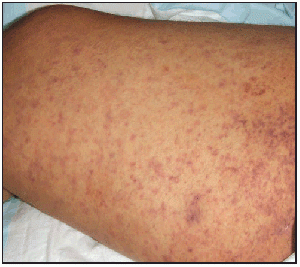Rocky mountain spotted fever
(Redirected from Rocky Mountain Spotted Fever)
Background
- Most frequent rickettsial disease reported in the US.[1]
- Caused by Rickettsia rickettsii
- Obligate intracellular, gram negative bacteria
- Predilection for vascular endothelial cells
- Spread by ticks
- American Dog Tick (Dermacentor variabilis) Most common vector
- Rocky Mountain Wood Tick (Dermacentor andersoni)
- Brown Dog Tick (Rhipicephalus sanquineus)
- Cayenne Tick (Amblyomma cajennense)
- Seasonal distribution with most infections occurring in the summer months
- Widely distributed in the US
- States with the highest incidence are Oklahoma, Nebraska, Arkansas, Tennessee and North Carolina
- Overall incidence is increasing while mortality is falling[2]
- Prior to the era of antibiotics, ~30% mortality
- Currently mortality is 3-5%
Clinical Features
- Symptoms generally begin 2-14 days after inoculation from an infected tick[3]
Early symptoms
- Non specific and highly variable
- Fever
- Nausea/Vomiting
- Abdominal pain
- Myalgias (severe calf pain)
- Headache
- Fatigue
- Conjunctivitis
Late symptoms
- Rash
- Begins as a blanching maculopapular rash that evolves to become a petechial rash
- Usually 2-5 days after fever subsides
- Starts on extremities and spreads inward (centripetally)
- Can involve palms and soles (50% of cases)
- Arthralgias
- Positive Rumpel-Leede test
- Development of petechiae at the site of blood pressure cuff and distally after compression
Complications
- Secondary to host response against infected endothelial cells
- Vasculitis
- Myocarditis
- Interstitial pneumonitis
- Encephalitis
Differential Diagnosis
- Other Tick Borne Illnesses
- Non-specific viral illness
Lower Respiratory Zoonotic Infections
- Psittacosis
- Anthrax (Bacillus anthracis)
- Brucellosis (Brucella species)
- Q fever (C. burnetti)
- Pasteurellosis (Pasteurella multocida)
- Melioidosis (Burkholderia pseudomallei)
- Rocky Mountain Spotted Fever (R. rickettsii)
- Pulmonic Plague (Yersinia pestis)
- Influenza A
- Hantavirus
Tick Borne Illnesses
- Babesiosis
- Colorado tick fever
- Ehrlichiosis
- Heartland virus
- Lyme
- Murine typhus
- Rocky mountain spotted fever
- Southern tick-associated rash illness (STARI)
- Tick paralysis
- Tularemia
Evaluation
- PCR (initially)
- Serial serologic examinations by indirect fluorescent antibody confirm the diagnosis
- Titers
Work-Up
- ECG (Myocarditis)
- Chem 7 (Hyponatremia)
- CBC (Thrombocytopenia)
Management
- Doxycycline 100 mg BID for 5-7 days[4]
- Indicated also in children at 2.2mg/kg BID
- Chloramphenicol (CAM) 50-100 mg/kg/day div Q6hr (Max dose = 4g/day)
- Preferred agent in pregnancy. May cause aplastic anemia and Grey baby syndrome, more common in near term or 3rd trimester[1]
- Consideration should be made for doxycycline over CAM in the 3rd trimester
Disposition
See Also
References
- ↑ 1.0 1.1 http://www.cdc.gov/rmsf/
- ↑ Columbia University Irving Medical Center. Rocky Mountain Spotted Fever. https://www.columbia-lyme.org/rocky-mountain-spotted-fever.
- ↑ http://www.mayoclinic.com/health/rocky-mountain-spotted-fever/DS00600
- ↑ Shandera WX, Roig IL: Viral & Rickettsial Infections, in Papadakis MA, McPhee SJ (eds): Current Medical Diagnosis and Treatment, ed 52. USA, McGraw-Hill, 2013, (Ch) 32: p 1412-1413.






